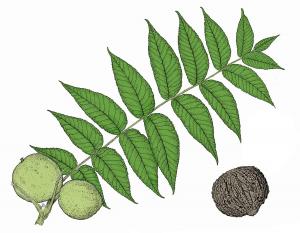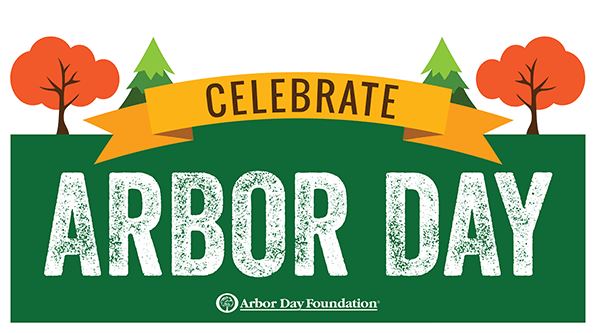BLACK WALNUT
Juglans nigra
Juglandaceae (walnuts)
A large tree with a straight trunk and rounded, open crown. The nuts, spicy odor, large feather-compound leaves, and chambered pith in the twigs help identify it.
Leaves alternate, compound, 1–2 feet long, with 11–23 leaflets. Leaflets 3–5 inches long, 1–2 inches wide, broadest below the middle, the end leaflet smaller than side ones or absent; margin toothed; upper surface yellow-green; lower surface paler, hairy.
Bark grayish-brown or black, grooves deep, ridges broad with sharp or rounded edges, roughly forming diamond-shaped patterns, chocolate-colored when cut.
Twigs stout, rigid, brown to gray-brown, hairy; end bud about ½ inch long; pith light brown, chambered when cut lengthwise.
Flowers April–May. Male flowers in catkins, female flowers in a short spike on the same tree.
Fruits September–October, usually single or in pairs. A green rounded husk, 1½–2½ inches across, covers the round, hard, bony, dark brown or black nut. The kernel is oily, sweet, and edible.
Similar species: Butternut, or white walnut (Juglans cinerea), is scattered and declining in the eastern two-thirds of Missouri, mostly in low and moist soils. It has rather cylindrical fruits, and the nut inside has 4 lengthwise ribs; leaf scars have the upper edge straight (not notched), bordered by a well-defined velvety ridge. The mild-tasting English (or Persian) walnut is the species J. regia. It is native to Eurasia and when cultivated in Missouri does not escape. The state of California grows nearly all of the US commercial supply of English walnuts. Walnuts are in the same family as hickories and pecans.
- Leaves long, alternate, feather-compound
- Leaflets 11–23, toothed
- Fruits distinctive
- Bark grayish, deeply grooved with rather diamond-shaped patterns, ridges broad
- Twigs stout, with chambered pith
- Distinctive spicy odor
Height: to 90 feet.
Missouri is the world’s top producer of black walnuts, which are used in baking and confections, and even pickled whole! It would be eaten by more people it getting the nutmeats out of the nut was easier. Walnut is the finest wood in the world. In the past, warm brown hardwood was used lavishly in homes, barns, and fences. Today it’s used for furniture, veneer, and gunstocks.
The nuts are eaten by mice and squirrels. The leaves are eaten by larvae of luna moths, regal moths, and others. The presence of such caterpillars naturally attracts warblers and other insectivorous birds. Walnut trees produce a chemical, juglone, that stunts or kills other plants growing nearby.
Black walnut has been designated as Missouri’s official state tree nut. Most of the state’s large, old walnut trees were felled in previous decades for lumber and other uses, yet the superb wood from this species remains in high demand. Young landowners have been planting walnuts in hopes of harvesting them in future decades. Several serious pests may endanger the health of Missouri’s walnuts; educate yourself about thousand cankers disease (TCD), ambrosia beetles, walnut anthracnose, and other diseases, and never, ever transport firewood.
Black walnut grows throughout Missouri in a variety of soils. It grows best on the deep, well-drained soils of north Missouri and on alluvial (river-deposited) soils in the south. Every farm in the state should grow some walnut trees. In addition to providing quality wood, the walnut’s nutmeats are a major industry in the state. Even the hard shells can be used as an abrasive and to make activated carbon.
It is a common misconception that tree services will pay the customer for removal of black walnut trees, due to their high-quality wood. However, this is not true. We at All About Trees will not pay to remove your black walnut tree.
Black Walnut. (n.d.). Retrieved October 10, 2017, from https://nature.mdc.mo.gov/discover-nature/field-guide/black-walnut
Springfield, MO Tree Alert- Our Certified Arborists
To view a list of our Certified Arborists, click here!
Please call the office of All About Trees at (417) 863-6214 or fill out a contact request form to schedule an appointment for an estimate.
Phone: (417) 863-6214
Address: 3427 W. Farm Road 146, Springfield, MO 65807




